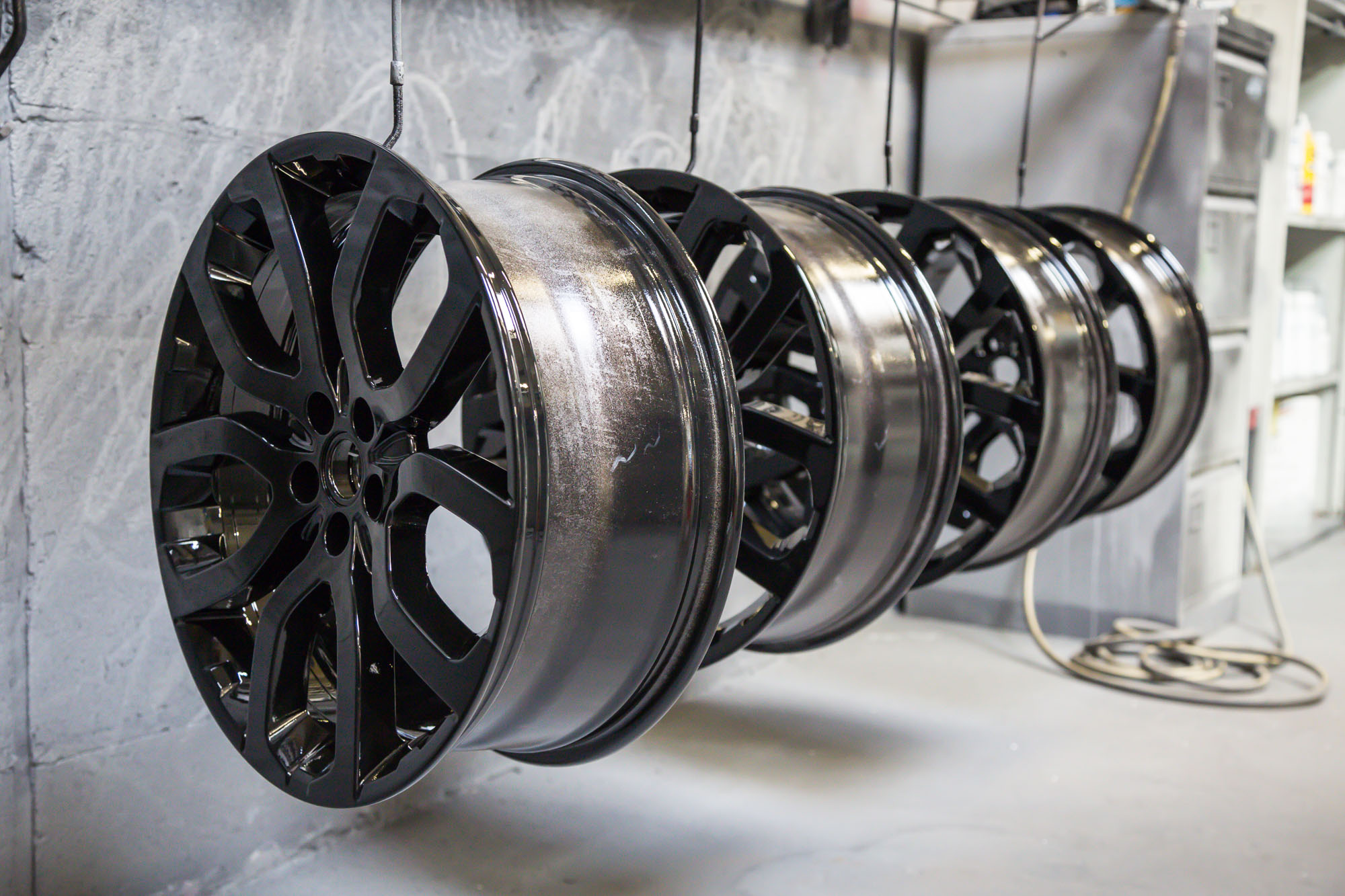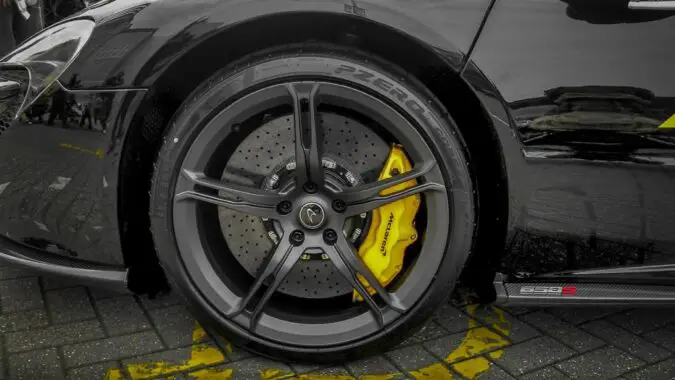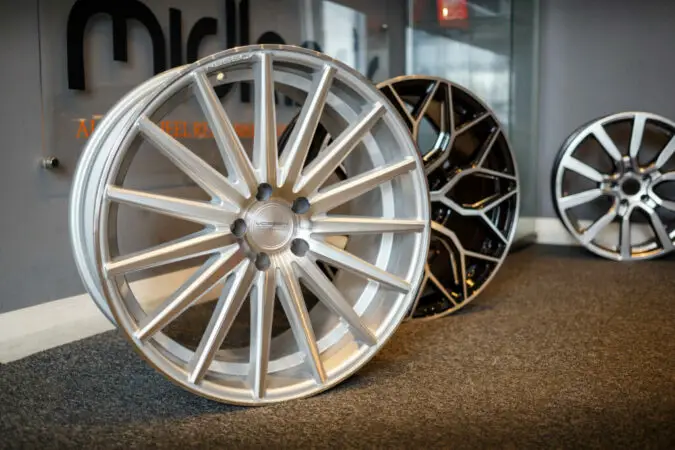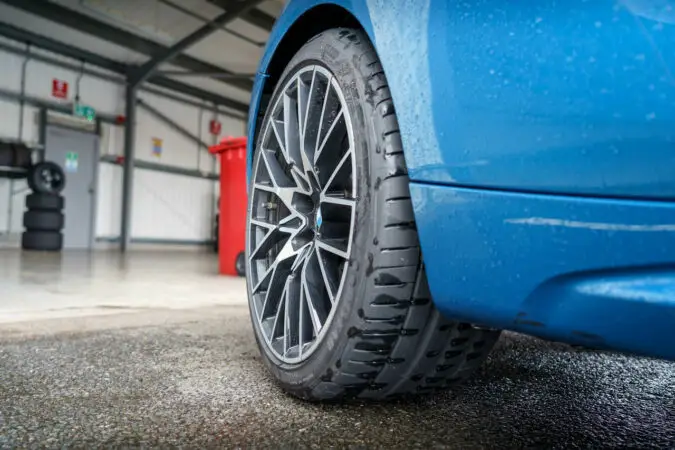Depending on the model you want, upgrading or replacing your rims will surely cost you a certain amount. So, how much are car rims? The rim will typically cost about $90.
But it will also go up based on the size and the materials used to improve, like steel, alloy, and chrome. Read on below to learn more about connected topics like why their prices are so expensive or what influences the pricing!
Types Of Wheels
Car wheels come in a huge variety, ranging from low-cost knockoffs to full-carbon stunners.
Although wheels may appear to be the simplest automobile part, major manufacturers are continuously discovering the strongest yet lightest materials to incorporate into their wheel production processes as well as inventing the newest and best production techniques.
Wheels have enormous mechanical and aesthetic duties that we gearheads shouldn’t take for granted, whether it’s Koenigsegg using entire carbon fiber wheels on the Regera or Jaguar replicating their infinitely cool steelies for the low-drag E-Type. So let’s quickly review the most common configurations found on contemporary cars, along with how their makers go about creating them.
Steel Wheels
The most basic kind of wheels is steelies. Steel wheels, which are pressed from steel billets using strong hydraulic equipment, have long been a regular feature on most affordable cars and predominated before alloy rims became more affordable to manufacture.
The iron and carbon alloy that makes up steel is a tougher metal than the majority of other materials used to make wheels, but this strength comes at the expense of weight when compared to materials like aluminum.
There is virtually little design freedom or another aesthetic flair possible with steel wheels due to the fundamental manufacturing process.
Once the welds wear down sufficiently, the various pieces of the wheel will be pressed out and joined to create the full wheel.
Because of this design, the only practical option to incorporate various designs—whether they be for airflow for cooling the brakes or for aesthetics—is to punch holes into the outside face of the wheel.
The way most businesses get past pressed steel wheels being unsightly is by adding a pair of hubcaps and some badging to cover up the raw metal and mimic a set of more expensive and fashionable alloy wheels.
Alloy Wheels
Up until the last ten years or so, alloys were only available on the most expensive models from a manufacturer. However, today, almost any city hatchback on the market may be specified with alloys if the buyer so chooses. Alloy wheels can be fully cast by pouring molten aluminum into a mold.
These wheels are based on an aluminum or magnesium construction combined with nickel and offer a significantly lighter package when compared to a steel wheel of the same strength.
You’ve probably heard the term “unsprung mass,” which describes the mass of parts that are not supported by the suspension, such as the suspension parts themselves, the brakes, and the wheels.
The lack of unsprung mass enhances handling because it enables the suspension to engage with an undulating road surface in a controlled manner and cope with the response forces from the road surface much more effectively.
Performance automobiles shifted to alloy wheels for this reason, as the lightweight design improved acceleration and a car’s overall characteristics.
You can make a wheel significantly more malleable and flexible by reducing the quantity of nickel in the alloy, expanding the design options. Over the years, this design flexibility has produced some amazing alloy rims, but the softer material also leaves room for some fairly disastrous outcomes when curbing a set of wheels.
Different Wheel Types And Their Production Process
Wheels are most famously produced by BBS and can be built from two or three fundamental parts. The wheel face (or centers) and the rim (or barrel) of two-piece wheels are connected by rim screws that go all the way around the wheel center.
https://www.youtube.com/watch?v=P7M-q3qv6Qw
The parts then further secure together by applying a ring of sealant to the connection.
Three-piece wheels go a step further by slicing the wheel rim in half to enable some wheel width adjustment. Multi-piece wheels are by nature heavier and slightly less strong than single-piece versions due to all of this fuss.
But, some manufacturers have come up with a rolled rim design that, by tempering the previously weaker metal, raises the strength levels of their multi-piece wheels to levels comparable to even single-piece forged wheels.
1. Alloy Wheels
The skill of forging aluminum results in some of the strongest wheels on the market. This is by crushing a billet of material into an incredibly dense and incredibly strong wheel by submitting it to exorbitantly high heat and pressure—roughly 900 bar.
These wheels are significantly stronger and lighter than a comparable cast wheel thanks to the enormous compression force produced by the forging process.
The internet seems to be full of offers for high-quality imitation or reproduction wheels for many different cars, but before clicking on any of these alluring deals, one should exercise utmost caution.
2. Replica Wheels
Although replica wheels may have a similar appearance to OEM wheels, they are sometimes constructed in the most inexpensive way feasible to lower production costs and miss several crucial strengthening techniques.
The majority of replica wheels are through the process of gravity casting, which involves pouring molten metal into a template without applying any pressure at all and allowing it to solidify only under the force of gravity.
This indicates that the alloy is not even close to being as dense as an OEM counterpart, which will have undergone some kind of compression throughout the manufacturing process. Because of this, the duplicate will be significantly weaker in contrast, which could be harmful.
With so many additional specialized wheel options available, a set of rims may be customized, such as being dipped in chrome, to meet any demand, whether it be for regular use, the occasional track day, or even a spot of off-roading now and again.
The ideal mix is waiting for you somewhere with the wide range of materials and manufacturing processes accessible in wheel production.
Rims vs Wheels
Do you understand the distinction between a pan and a pot? For years, the issue has sparked contentious discussions around the dinner table and widened divisions. Who’s correct?
While pans are shallow and used to fry food with concentrated heat, pots have deeper sides. However, I digress.
Discussions on rims versus wheels for your car can also heat up. What is the name of the tire’s metal component? Wheel? Rim? Is there a difference? Yes. I’d say there is.
Although many people c0nfuse wheel and rim frequently, they are not the same thing. One of several parts that make up a wheel is the rim. The rim acts as a form of reinforcement to hold the tire to the wheel and is located on the outside edge of the wheel.
The central wheel disc and spokes, which are likewise a part of the wheel, are not rims. Many also confuse wheels that are aftermarket or decorative, such as aluminum alloy wheels. Why? Maybe it’s the fact that Nice rims sound more hipster than “Nice wheels”?
We’re about to explain what rims, and wheels are, and the distinction between the two is whether you’re trying to “be right” in a friendly conversation or you’re shopping for wheels and/or tires.
1. What Do Rims Do
The outer edge of something is generally referred to as its rim, and in this instance, that outer edge is the wheel. The tire is secured to the rim. It usually has a U-shape when viewed from above, with the center being deeper than the borders. The reason behind its design is to support the tire bead.
The rim typically comprises the same metal or alloy as the rest of the wheel and has a Teflon covering for added safety. The main function of a rim is to hold and secure the tire to the wheel. By ensuring a proper fit, the rim helps keep the air (e.g prevents a leak) in the tubeless tire.
Then, what is a wheel?
The wheel is the full piece of metal that supports the tire. The wheel refers to the entire assembly, including the tire. However, this is not always the case.
Numerous parts make up the wheel. Lug nuts help secure the hub, or center disc, which joins the wheel to the vehicle’s axle.
The size of the rim determines the size of the tire that should go with your car, even though some wheels have larger or smaller tires than the rim. Use only tires that are appropriate for your wheels.
2. Are Wheels And Tires Interchangeable
Some people mistakenly use the terms tires and wheels interchangeably, as when they say “give me a pan” when they truly mean “hand me a pot.”
The wheel is a piece of metal that an automobile’s hub is attached to by way of an axle. On the other hand, the tire is a rubber casing that is fastened to the wheel. The center cap, spokes, lug holes, and valve stem are further components of the wheel.
Hubcaps, which are detachable covers that snap into place and are used to protect the interior components of wheels, are often included with wheels.
3. Do You Need Rims Or Wheels
So there you have it. The wheel is the full metal component that supports your tire. The wheel’s rim is its outermost portion. I need a new set of rims sounds more awesome in auto body slang, so maybe that’s why “rim” has evolved to be synonymous with “wheel” for some reason.
Customers often purchase new wheels for one of two reasons: either to replace broken wheels or to give their cars a fresh new look.
4. Replacing Damaged Wheels
Signs of rim damage include steering vibration, abrupt changes in an automobile’s handling characteristics, and a tire that constantly loses air pressure. Due to the tire and hub covering the rim, not all rim damage is visible, but there may be telltale signs of damage.
If you don’t fix rim damage, the metal components of the wheel assembly may rub against the tire, leading to blowouts or the need for continual tire inflation. Damaged rims and wheels can be dangerous since they can make drivers lose control of their cars.
The most frequent causes of rim damage are objects and large potholes. Good day, city council.
When drivers strike curbs on turns (often right-hand turns), or when they parallel park too near to the curb, they frequently cause damage to the wheels and rims. Road salts can also corrode and eat away at your rims if you reside in a location that experiences frequent snow and ice storms in the winter.
Age and heavy use, which can cause them to wear out over time, are additional reasons you might need new wheels.
Rims vs Hubcaps
Unquestionably, the practical side of automobiles is the most crucial, but we can all appreciate a well-designed car and are willing to make concessions to make our cars appear as nice as they possibly can.
There are numerous routes you can take for your changes, but let’s talk about hubcaps and rims for the time being.
Hubcaps and rims differ most significantly in their uses. While hubcaps are decorative items that cover the outside of the wheel, the rims are a structural and important component of the wheel. The hubcap is entirely optional, however, the rim is a requirement for every wheel.
The hubcap is a cap that protects a wheel’s hub. It may be decorative or useful and is often comprised of metal or plastic. The lug nuts can occasionally get protection from the hubcap as well.
The fasteners that secure the wheel to the car are the lug nuts. The lugnuts may rust and become challenging to remove if you expose them to dampness. The hubcap keeps the lugnuts clean and shields them from moisture and debris.
Hubcaps are available in a wide range of shapes, sizes, and designs, and there are numerous ways to connect them to the wheel. Because of this, they are simple to alter and customize (such as applying powder coating). Many people opt for hubcaps that complement the color of their car or have a pleasing pattern.
The majority of hubcaps are easily replaceable in case they damage. Hubcaps can either fasten on or held in place with clips. Some hubcaps are wheel-snapping devices.
The Edge
The metal core of a wheel that houses the tire is the rim. It determines the form of the tire and offers structural support.
Although the terms “rim” and “wheel” are frequently used interchangeably, they are not the same thing because the wheel also includes the tire. Rims comprise magnesium, aluminum, or steel. To fit various tires, they are available in a variety of diameters and widths.
Hot forging is the method that helps to make the majority of rims. This procedure involves heating metal to a high temperature before shaping it into the required shape. To cast rims, molten metal is put into a mold.
Rims can be spoken, multi-spoke, or solid, among other designs. Spoke rims have thin, uniformly spaced spokes that extend outward from the wheel’s center. The spokes on multi-spoke rims are thicker and less uniformly spaced. Rims with no perforations are solid, as the name implies.
Your personal preferences and the kind of vehicle you drive will determine the kind of rim you select. Sports cars frequently have spoked wheels, whilst luxury automobiles frequently have solid wheels.
Differences Between Rims And Hubcaps
1. Material
Because they are solely for decoration, hubcaps comprise less expensive materials like plastic.
Aluminum, steel, or magnesium are the materials that help to make rims, which then receive a paint job or a chrome finish. This is so that they can sustain the weight of your car, which requires that they be stronger.
2. Weight
Hubcaps only weigh about a pound, which is extremely light. Rims weigh substantially more and can range in weight from 10 to 25 pounds, depending on the material and size.
3. Function
Hubcaps are decorative components on the steel wheels. Driving on exposed steel wheels is perfectly legal, but they seem cheap and detract from the aesthetic of the car.
The whole wheel is made up of the tire and the rim. The tire delivers a smooth ride with lots of grips. The rim offers structural stability and a way to attach to the car.
You can almost always find a good design with non-steel rims that looks better than hubcaps.
4. Which Is Superior, Hubcaps Or Rims
We can only talk about the aesthetics and contrast steel rims with hubcaps with aluminum rims because rims are necessary and hubcaps are optional.
It’s not a contest, although the aluminum rims nearly always come out on top in terms of appearance. Although hubcaps can be attractive, you can always see the difference.
Which choice is preferable may be greatly influenced by your price. Hubcaps can be purchased for less than $50, but how much are car rims? Aluminum rims cost at least $200. This is for a pair of used ones and probably considerably more for a brand-new set.
Best Wheel Brands
Car lovers often want to find the greatest rims for a polished appearance. They also anticipate getting the best wheels for their vehicle. Despite the market’s extensive selection of car rim options, you can find the top rim brands supplying rims that are appropriate for your vehicle.
Even though selecting the best options could seem challenging, below are some of the top rim manufacturers. Because of this, you can depend on the rim companies listed below to provide aesthetically beautiful and top-notch rims.
How Much Are Car Rims, Top Brands #1: Konig
But how much are car rims? let’s talk about Konig. This company offers among the most incredible car rims on the market. Top-quality rims and wheels from Konig are a result of top-notch technologies.
Intriguingly, Konig focuses on providing wheels that are lightweight but have great technological advancements.
Because of the superb craftsmanship of its goods, this brand is one of the many options that car owners select.
Konig wheels and rims have outstanding shock resistance and contribute to high load capacity. Because these products from this business fulfill quality requirements and have some excellent OEM features, you can be sure that these wheels and rims will last for a very long time.
How Much Are Car Rims, Top Brands #2: Enkei
Are you still wondering how much are car rims? A look at the company Enkei as it stands out as one of the best aftermarket rim brands and provides some of the most affordable options for customers who want to upgrade their rims.
The wide variety of rims offered by this manufacturer may seem to be the best option for new car owners who are not familiar with the complexities of rims.
The good news is that this manufacturer offers rims all around the world, making their goods some of the greatest rims you can purchase from various auto shops. Since the establishment of the business in the 1950s, they have gained a reputation for providing durable and lightweight rims.
How Much Are Car Rims, Top Brands #3: Vossen
Vossen is a firm that creates excellent one-piece alloy wheels due to the availability of high-quality rims in traditional designs. This brand has rims that would suit your driving tastes and sense of style if you’re searching for wheels with a very sporty touch.
Modern casting techniques help create Vossen’s rims, allowing for effective flow shaping. This business, which has its headquarters in Miami, Florida, features a variety of production-supporting equipment.
How Much Are Car Rims, Top Brands #4: TSW
If you are still asking yourself how much are car rims, then you might want to consider TSW. The company stands out as one of the best car wheel brands and provides a wide variety of rims. As a result, drivers can search for excellent options that can improve the performance and aesthetics of their automobiles.
In essence, rims come in chrome, silver, bronze, gold, as well as black. Despite the numerous options available to drivers as well as car owners, you can be sure that this company will offer rims that meet your requirements and look fantastic on your vehicle.
How Much Are Car Rims, Top Brands #5: OZ Racing
OZ Racing is a popular company in the industry, and as a result, they are on the list of the best rim manufacturers as of late. As one of the leading rim suppliers on the market, this company excels at offering rims that satisfy the various needs of clients.
The Italian aftermarket rim manufacturer has a well-established reputation for creating aftermarket rims of the finest quality. Once again, the custom wheels make it great for cars since they fit well while also meeting the requirements of the car.
FAQs On How Much Are Car Rims
How Much Do New Tires Cost
Generally speaking, inexpensive tires cost between $50 and $150 per unit. The normal price range for tires with a reasonable price tag is $100 to $300 per tire. High-end tires can cost between $300 and $1000 per unit, including specialty or ultra-high-performance off-road tires.
Are Tires Wheels
Are wheels and tires the same? Although the words tires and wheels are occasionally used interchangeably, they are not the same thing. The rims that tires are mounted on are known as wheels. The rubber ovals that are put on the wheels are called tires.
What Are Rims On A Car
The part of the wheel which supports the tire is the rim. The circular outer pattern of the wheels installed on cars and other cars is made up of it.





